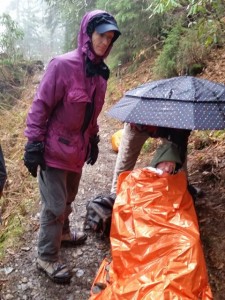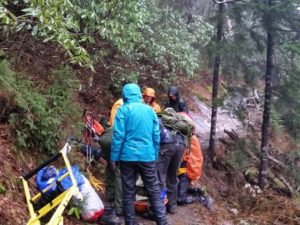Yesterday, Jon Holliday of Cary recounted how an annual tradition for four hiking buddies — Pete Sprague of Asheville, David Sprague of Boone and Scott Duffy of Charlotte and himself — took a turn when Pete fell and broke a leg. Today, the rescue.

It would be three hours before a first responder could reach the scene, a dispatcher for the Great Smoky Mountains National Park told the hikers. Though it wasn’t cold, the torrential rain meant keeping Pete warm would be a top priority. That’s where Mr. Silly from Saturday turned into Sunday’s savior. He happened by shortly after Pete fell; his beach chair was just what was needed to keep Pete off the wet ground and keep him from slipping into shock. The umbrella came in handy, too, as did the space blanket Jon had purchased just three weeks earlier.
As predicted, Park Service Medic Les Kwiatkowski arrived about 1:30 p.m., three hours after Pete went down.
“He did an assessment of Pete and the injury, relayed the info to the dispatcher, and placed a splint on Pete’s right leg,” Jon said. “He also trenched the trail to route the water running down the trail around Pete. From that point, Les continued to monitor Pete and stay in communication with the dispatcher while we waited for the rescue team.”
A second medic arrived around 3:30 and administered the pain medication that would make Pete’s bouncy ride down the mountain bearable. A half hour later, more than a dozen rescue team members arrived with a basket litter and a wheeled Teton litter. They also brought gear for an overnight stay if conditions warranted.
“They moved Pete into a zero degree sleeping bag inside a waterproof bivy sack, placed a helmet on him, and strapped him into the basket litter. They then strapped the basket to the wheeled Teton litter and the rescue team and I started down the mountain together.”

The evacuation begins
It was 4:30. They had three miles of trail ahead of them. The sun would set in about an hour, and the wind and rain were picking up.
Slowly, they began down the mountain.
Jon describes the contraption and process that would help get Pete off the mountain:
“The wheeled Teton litter had a single motorcycle tire in the center of an aluminum frame, with two handles and a hand brake on the back. On the front, a person would get inside a step-through bar on the litter — like you see when people are pulling rickshaws. These two people would guide the Teton litter and control the speed. Two people on each side of the litter would help guide it, lift it over obstacles, and keep it upright as needed. After a while, the team would stop and people would swap off with others when they were too tired to keep going. When the trail got too narrow for people to be on both sides, they would line the trail standing on the mountain sides and pass the litter from one person to the next. At times, they would hook onto the sled when there was a danger of falling themselves. Throughout the rescue, team members were calling out commands to ensure obstacles were seen before the litter got to them, to halt the litter if needed, and to control the speed of the transport as required.
“The last guy, the trailer, was carrying the beach chair and walking with the polka dot golf umbrella open over his head. He said if he had to carry it he may as well use it. People were giving him a hard time, of course.”

Water, water everywhere
Soon, it was dark and the wind had become more ominous. And there was the water.
“Water was pouring down the trail, running down the mountainsides over the rock walls creating new waterfalls, and previously shallow creeks were now rushing streams, one time coming over my boots filling them with water,” says Jon. “You could hear the water rushing around you through the forest and see the whitewater like a trail through the forest from the reflections of our headlamps.”
They made a brief pitstop in an overhang at Alum Cave Bluffs, swapping out headlamp batteries, grabbing a snack, catching their breath. Then they pressed on.
“We came to an area where the trail is routed up and over the root section of an old downed tree,” Jon said. “The litter had to be lifted and turned sharply to get over that obstacle. Rescue personnel were standing awkwardly all over the sides of the trail and on the roots of the downed tree to get through.”
At a series of steps at Arch Rock, Pete and his sled had to be belayed using a series of ropes set up by the rescue team. Once they’d passed that obstacle, another arose: a one-log bridge crossing common in the Great Smokies.
“It was very tricky to lift the litter onto the bridge and keep the tire centered on a 18 inch wide log with a rail on just one side, with rescue personnel on the back and front and in the stream guiding the litter along when possible,” said Jon. It was the first of many such bridges they would have to negotiate in the last mile and a third.
“One seemed like it was only 12 inches wide,” Jon said.
At the trailhead, 10 hours later
“We finally made it to the parking lot and a waiting ambulance at 8:30 p.m, 10 hours after the accident occurred,” Jon said.
Pete was transported to LeConte Medical Center and put in a full leg cast. Three days later he had surgery in Asheville. He’s expected to be off the trail for at least eight weeks.
What might seem like a harrowing experience to some was, to Jon, just another adventure on the trail that was handled by following some common sense rules of hiking.
Know where you are at all times. Knowing the trail as well as Jon did helped: they were able to let rescuers know their precise location. A map is essential, as is a compass. A passing hiker had an altimeter and was able to provide a precise elevation, which helped rescuers as well.
Hike prepared. Jon and his buddies weren’t expecting to hike at night, but they all had headlamps — and extra batteries. “I always pack a first-aid kit, rain gear and extra food,” said Jon, “even on short hikes at Umstead. You never know what might happen.”
Try to hike in groups of three or more. The power of numbers was key to Pete’s rescue, said Jon. “If it’s just two of you and one of you gets hurt, then you have to decide between going for help and staying with the injured person.”
Make sure you don’t become part of the problem. Hiking down, Jon was in the company of qualified rescue personnel. “I was carrying some gear, but my main goal was to be careful and not add to the problem.”